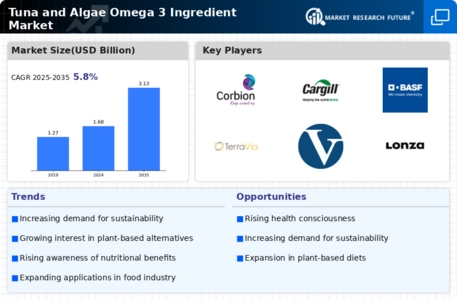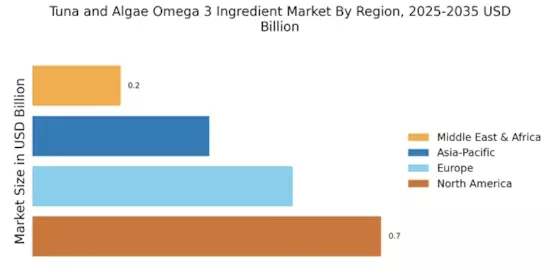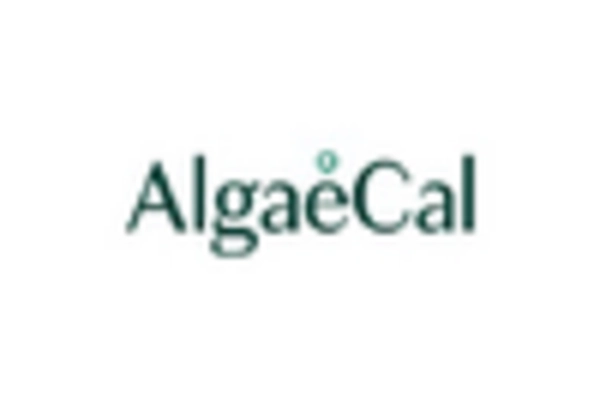Rising Popularity of Plant-Based Diets
The Tuna and Algae Omega 3 Ingredient Market is influenced by the rising popularity of plant-based diets. As more individuals adopt vegetarian and vegan lifestyles, the demand for plant-derived omega-3 sources, particularly algae, is increasing. Algae-based omega-3 supplements are perceived as a sustainable alternative to fish-derived omega-3s, appealing to environmentally conscious consumers. Market data suggests that the plant-based food sector is expanding rapidly, with a significant portion of consumers actively seeking plant-based omega-3 options. This shift in dietary preferences is prompting manufacturers in the Tuna and Algae Omega 3 Ingredient Market to innovate and diversify their product offerings to meet the evolving demands of health-conscious and environmentally aware consumers.
Sustainability and Environmental Concerns
The Tuna and Algae Omega 3 Ingredient Market is significantly impacted by growing sustainability and environmental concerns. Consumers are increasingly aware of the ecological implications of overfishing and the depletion of marine resources. As a result, there is a marked shift towards sustainable sourcing practices, particularly in the tuna sector. Algae, as a renewable resource, presents a viable alternative that aligns with consumer preferences for environmentally friendly products. This trend is prompting companies within the Tuna and Algae Omega 3 Ingredient Market to adopt sustainable practices and transparently communicate their sourcing methods to build trust with consumers. The emphasis on sustainability is likely to drive innovation and investment in algae-based omega-3 products.
Growth in Functional Foods and Supplements
The Tuna and Algae Omega 3 Ingredient Market is witnessing a notable expansion in the functional foods and dietary supplements sector. As consumers seek products that provide additional health benefits beyond basic nutrition, omega-3 enriched foods and supplements are gaining traction. According to recent data, the functional food market is projected to grow significantly, with omega-3 products being a key segment. This trend is driven by the increasing prevalence of lifestyle-related health issues, prompting consumers to opt for preventive health measures. Manufacturers are responding by incorporating tuna and algae omega-3 ingredients into a variety of products, from fortified snacks to dietary supplements, thereby enhancing their market presence and catering to health-conscious consumers.
Regulatory Support for Omega-3 Fortification
The Tuna and Algae Omega 3 Ingredient Market is benefiting from increasing regulatory support for omega-3 fortification in food products. Governments and health organizations are recognizing the importance of omega-3 fatty acids in public health and are encouraging their inclusion in various food items. This regulatory backing is likely to stimulate demand for omega-3 ingredients derived from both tuna and algae. As regulations evolve to promote healthier food options, manufacturers are presented with opportunities to enhance their product lines with omega-3 fortification. This trend not only supports consumer health initiatives but also positions the Tuna and Algae Omega 3 Ingredient Market for growth as more products enter the market with omega-3 enrichment.
Increasing Consumer Awareness of Omega-3 Benefits
The Tuna and Algae Omega 3 Ingredient Market is experiencing a surge in consumer awareness regarding the health benefits associated with omega-3 fatty acids. Research indicates that omega-3s play a crucial role in cardiovascular health, cognitive function, and inflammation reduction. As consumers become more informed about these advantages, the demand for omega-3-rich products, including those derived from tuna and algae, is likely to rise. This heightened awareness is further fueled by social media and health campaigns that emphasize the importance of omega-3s in daily diets. Consequently, manufacturers in the Tuna and Algae Omega 3 Ingredient Market are increasingly focusing on product innovation and marketing strategies that highlight the health benefits of their offerings.


















Leave a Comment